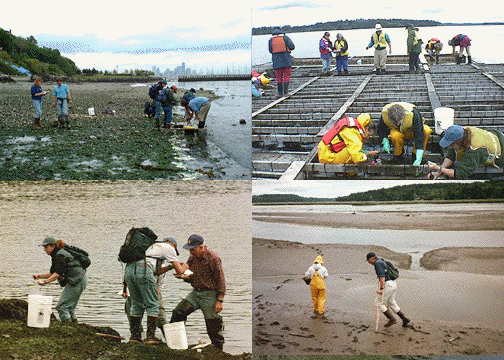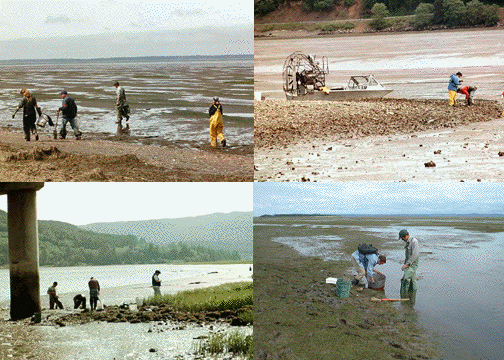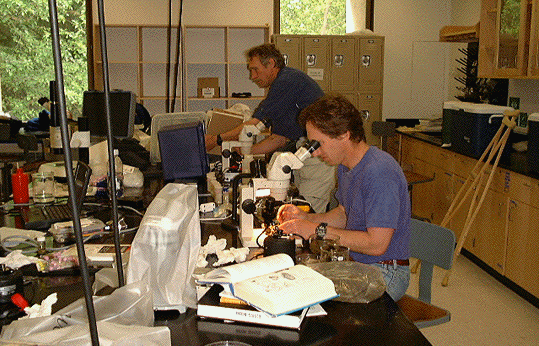THE PUGET
SOUND EXPEDITIONS
Puget
Sound / Willapa Bay Expedition 2000
This was the second in a series
of team-expeditions examining the marine fauna and flora of Washington
State, with a eye to the level of invasion of marine habitats
by nonindigenous species. The Washington State Department of Natural
Resources Nearshore
Habitat Program was again the primary sponsor of the
expedition. Again, the field work comprised a rapid
assessment survey by a group of taxonomic and nearshore specialists.
Whereas the 1998 Puget Sound Expedition
sampled primarily marinas, with a brief look at a few nearby intertidal
habitats, the year 2000 Exotics Expedition emphasized cobble/sandy
and muddy beach habitats, with a few additional marinas, and made
an effort to sample several very-low salinity sites.
The Puget Sound / Willapa Bay Expedition
2000 took place May 17-23, 2000 and included more than 20 scientists
(listed below), of whom about 15 were present each day. We sampled
in three main regions: Elliott Bay, Puget Sound, in Seattle (2
days, 7 sites), Totten and Eld Inlets in south Puget Sound near
Olympia (2 days, 6 sites), and Willapa Bay on Washington's outer
coast (2+ days, 15 sites). In Willapa Bay, the team split into
two groups, so that half could sample from an airboat, while the
others approached different locations from land. The full sampling
schedule with site names is given below.

Field work at Puget Sound sites (clockwise from upper left):
Magnolia Park in Seattle, Taylor Shellfish mussel raft in Totten
Inlet,
Kennedy Creek in Totten Inlet, Steamboat Island at junction of
Totten and Eld Inlets
Photographs
by Kevin Li and Claudia Mills
For the Year 2000 Expedition, we
tried for the first time to do lab work on the same days as collecting,
which allowed the scientists to look at live, instead of preserved,
material daily. Because of the distance between sites, this caused
us to use three different lab facilities spaced around the region,
at the University of Washington at Tacoma, the Evergreen State
College in Olympia, and the Ocean Park Retreat Center at Willapa
Bay. Although so much moving around caused extra packing and unpacking
of gear, working on live material seemed to offer an advantage
that far outweighed the disadvantages, and the grueling, several-day
laboratory marathon that has characterized earlier expeditions
was thus avoided.
By combining the results of the
Year 2000 Exotics Expedition with that of the 1998 Puget Sound
Expedition, the list of non-indigenous species for Puget Sound
should now be more comparable to similar lists for other large
estuary systems (San Francisco Bay and Chesapeake Bay). This time
we made an effort to reach the shallow, often warmer and with
low salinity, heads of bays and inlets around Puget Sound and
Willapa Bay. Such habitats are considered by many scientists to
be particularly vulnerable to colonization by alien/exotic species
from abroad.
Willapa Bay results will be interesting to compare with the findings
from sites further north on the Washington outer coast sampled
by the 2001 Olympic Coast National Marine
Sanctuary Expedition.

Field work at Willapa Bay sites (clockwise from upper left): Goose
Point near Bay Center,
airboat transportation at Round Island, Stackpole Slough, Naselle
River under the bridge
Photographs
by Kevin Li and Claudia Mills.
Our findings, in brief:
The Puget Sound / Willapa Bay Expedition
of 2000 was the sixth in a series of Rapid Assessment surveys
for exotic marine organisms in California and Washington. Three
regions in Washington State were sampled to capture a range of
oceanographic conditions and patterns of human use: Elliott Bay
and the Duwamish River estuary are located in the Central Basin
of Puget Sound, near the City of Seattle; Totten and Eld Inlets
are relatively protected bays in the Southern Basin of Puget Sound,
with predominant aquaculture and residential land uses; Willapa
Bay is Washington's largest outer coast estuary and is the state's
largest aquaculture center. As in past surveys, our primary objective
was to assess the status of exotic invasions within defined regions
and habitat types through nonquantitative census methods. Secondary
objectives were to obtain data for comparisons between habitats
and regions, and for comparisons with past surveys; to obtain
baseline data for future assessments of changes in invasion status
and the effectiveness of prevention or control efforts; to detect
new invasions and document significant range extensions; and to
identify new species.
As of October 2001, 40 exotic species
have been identified from the 2000 Expedition. Most of
these are native to the North Atlantic or the Northwestern Pacific
region, and most were
introduced to the Northeastern Pacific with oysters imported for
aquaculture, as ship fouling
organisms or in ballast water. Among the three regions, 15 exotic
species were collected in each of the Elliott Bay and Totten/Eld
Inlet regions, and 34 exotic species were collected in Willapa
Bay. The apparent ecological dominance by exotics was slightly
greater in Totten/Eld Inlets than in Elliott Bay, and much greater
in Willapa Bay; thus the greatest number and extent of invasions
was found in the least physically-altered system. The shipment
and planting of oysters for commercial aquaculture is considered
to be a possible mechanism responsible for introducing onto the
Pacific Coast 35 of the 40 exotic species collected by the Expedition.
In contrast, ballast water is considered a possible transport
mechanism for 13 of the species, and all ship-associated mechanisms
together (ship-fouling, solid ballast and ballast water) for 28
of the species. All of these mechanisms would also be effective
at moving organisms between bays on the Pacific Coast.
How to get a copy of the final
report:
The report of the Washington State
Exotics Expedition 2000 (a rapid assessment survey of exotic species
in the shallow waters of Elliott Bay, Totten and Eld Inlets, and
Willapa Bay) was released in October 2001 and is now available
in both .pdf format directly on the web and in print form. Click here to download the entire document
on the web, or here
for a second location, or write for a paper copy to the Nearshore
Habitat Program, Washington State Department of Natural Resources,
1111 Washington Street SE, PO Box 47027, Olympia, WA 98504-7027;
telephone 360-902-1100.
The NIS results of the 1998 Puget
Sound Expedition are also available
on the web, or in printed form from the Washington State Department
of Natural Resources and are also on
the web in abbreviated list form (which contains corrections
over the paper copy). A
peer-reviewed version is now published in Marine Bioinvasions:
Proceedings of the First National Conference (2000).
Schedule for the Puget Sound
/ Willapa Bay Expedition - May 17-23, 2000.
Expanded
site descriptions are available on another page here with
links to photographic images in the Washington
State Department of Ecology Shoreline Photo database on the
web - these (10,000) photographs were taken between 1992 and 1997.
May 16 (Tuesday)
Assemble the team in Seattle.
May 17 (Wednesday)
ELLIOTT BAY
Low tide -0.5
' at 1125 (Seattle prediction).
1. Bell Harbor Marina, Pier 66 (8:30-9:30 am)
2. Myrtle
Edwards Park, in front of Elliott Bay Fishing Pier (10:30-11:10 am)
3a. Sandy
north-facing beach south of Pier 90 (10:50-11:50 am)
3b. Smith
Cove (north of Pier 91) (11:45
am)
4a. Magnolia
Park beach, north Elliott Bay
(12:30-1:25 pm)
4b. Elliott
Bay Marina, north Elliott Bay (3:40-5:00
pm)
Afternoon and evening lab work at
University of Washington Tacoma.
May 18 (Thursday)
ELLIOTT BAY
Low tide -0.9
' at 1156 (Seattle prediction).
5. Duwamish
River, western channel across from Kellogg Island (9:30-10:40 am)
6. Seacrest
Park, Duwamish Head, south Elliott Bay (10:50-11:50 am)
7a. Turning basin, Duwamish River (12:40-1:20
pm)
7b. Duwamish Yacht Club marina, Duwamish River (1:45-2:15 pm)
Drive to Olympia. Afternoon and
evening lab work at the Evergreen State College.
May 19 (Friday)
TOTTEN INLET
Low tide -1.1
' at 1328 (Seattle prediction + 1 hour).
8a. Taylor Shellfish boat ramp,
Totten Inlet (9:20-9:50
am)
8b. Taylor Shellfish mussel rafts, Gallagher
Cove, Totten Inlet (10:00-11:10
am)
9. Kamilche
Point at junction of Little Skookum Inlet and Totten Inlet
(12:30-1:40 pm)
10. Kennedy
Creek at head of Totten Inlet (2:25-3:15
pm)
Afternoon and evening lab work at
the Evergreen State College.
May 20 (Saturday)
ELD INLET AND TOTTEN INLET
Low tide -1.1
' at 1402 (Seattle prediction + 1 hour).
Morning lab work at the Evergreen
State College.
11. The
Evergreen State College Beach, Eld Inlet (12:20-1:00 pm)
12. Steamboat
Island at junction of Totten Inlet and Eld Inlet (1:45-3:00 pm)
13. Mud
Bay at head of Eld Inlet (4:55-5:25
pm)
Drive to Willapa Bay (3 hours).
May 21 (Sunday)
WILLAPA BAY
Low tide -1.0
' at 1036 (Aberdeen prediction + 30 minutes).
14. Naselle River Bridge (9:15-10:00 am)
15. Goose Point near Bay Center (10:45am-12:30
pm)
16. Port of Bay Center, small boat harbor (1:10-1:45 pm)
17. Palix River "freshwater" site (9:55-10:35 am)
18. Palix River pilings site (10:50-11:05
am)
19. Oyster
flats south of Wilson Point (11:20-11:40
am)
20. Palix
River Spartina control site and Palix
River Bridge pilings (12:00-12:20
pm)
Afternoon and evening lab work at
Ocean Park Retreat Center.
May 22 (Monday)
WILLAPA BAY
Low tide -0.7
' at 1113 (Aberdeen prediction + 30 minutes).
21. Stackpole
Slough in Leadbetter Point State Park (10:45am-12:00 noon)
22. Nahcotta
Small Boat Basin, Port of Peninsula (1:40-2:30 pm)
23. Omeara
Point mudflat (9:45-11:00
am)
24. Round Island (11:20-11:50
am)
25. Bear
River (12:00-12:30
pm)
26. Shoalwater
Bay (1:00-1:15
pm)
27. Long Island, south end (1:20-1:45
pm)
Afternoon and evening lab work at
Ocean Park Retreat Center.
May 23 (Tuesday)
WILLAPA BAY
Low tide -0.2
' at 1152 (Aberdeen prediction + 30 minutes).
Labwork and data summaries all day
at Ocean Park Retreat Center.
28. Leadbetter
Point sandy beach (12:30-1:00
pm)
May 24 (Wednesday)
WILLAPA BAY
Finish labwork and data summaries,
cleanup Ocean Park Retreat Center.

John Chapman and Andy Cohen working
up material at the Evergreen State College.
Photograph
by Claudia Mills.
Participants:
Helen Berry - Washington DNR Nearshore
Habitat Group
Brian Bingham - Western Washington University (general invertebrates;
teaches university students in north Puget Sound and NW Straits
region)
Betty Bookheim - Washington DNR Nearshore Habitat Group
Kevin Britton-Simmons - University of Chicago and FHL (algae and
invertebrates)
Jeb Byers - Friday Harbor Labs, University of Washington (ecosystem-level
effects of exotic marine species)
John Chapman - Hadfield Lab, Oregon State University (small crustaceans;
exotics)
Andy Cohen - San Francisco Estuary Institute (general invertebrates
and exotics, especially San Francisco Bay)
Jeff Cordell - Fisheries, University of Washington (copepods and
other small crustaceans)
Brett Dumbauld - Washington Dept. Fish Wildlife, Willapa Bay field
station
Allan Fukuyama - Fisheries, University of Washington (bivalve
molluscs)
Leslie Harris - Los Angeles County Museum (polychaete worms)
Alan Kohn - Zoology, University of Washington (molluscs; general
invertebrates)
Kevin Li - King County Environmental Lab (amphipods and other
small crustaceans)
Dave Milne - Evergreen State College (marine biology; teaches
university students in south Puget Sound region)
Claudia Mills - Friday Harbor Labs, University of Washington (medusae
and ctenophores)
Tom Mumford - Washington DNR Nearshore Habitat Group (algae)
Vasily Radashevsky - visiting scientist from Vladivostok, Russia
(polychaete worms)
Dave Secord - University of Washington, Tacoma (marine ecology,
sea anemones; teaches university students in south Puget Sound
region)
Amy Sewell - Washington DNR Nearshore Habitat Group
Kathy Welch - Washington Dept of Ecology (polychaete worms)
Marjorie Wonham - Zoology, University of Washington (general invertebrates;
Mytilus)
Jessica Barkas - undergraduate student in Zoology, University
of Washington
This
site is maintained by C. E. Mills; photographs should not be used
without permission.
** This page was established May 2000; last updated 17 May 2002
**
Mills
Home | Hydromedusae
| Aequorea | Stauromedusae
| Ctenophores
List of Stauromedusae
| List of Ctenophores
San Francisco
Bay Expeditions | Puget Sound Expeditions
| Olympic Coast Expeditions
Marine
Conservation | Publications
| What's Happening
Marine Research Study Sites in the
San Juan Islands
Friday Harbor
Laboratories Terrestrial Preserve
Centennial Historical Timeline
of the Friday Harbor Labs


